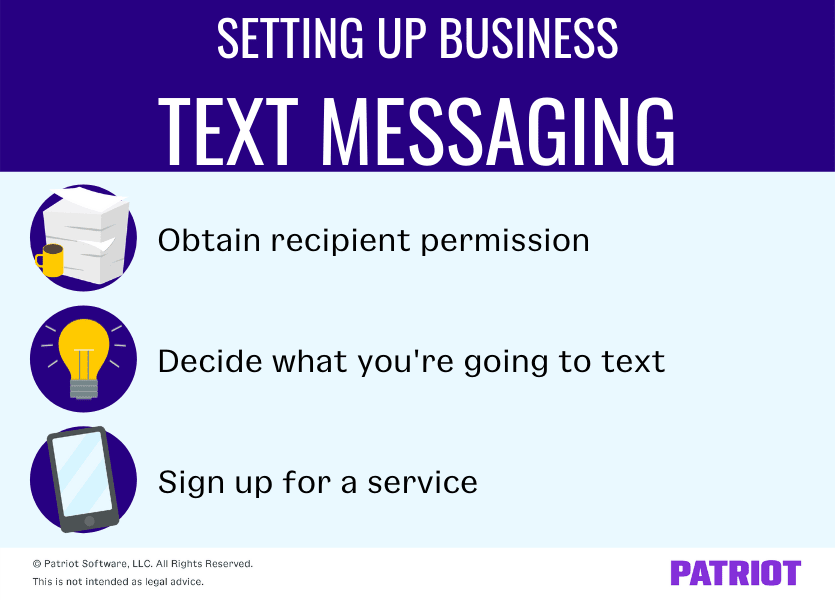You’re always on the hunt for new and improved ways to streamline business processes, like marketing and customer service. The next big thing? Texting in business.
No, this isn’t about your employees sitting and texting their friends and family while on the job (that’s time theft). It’s about sending out text messages to your customers to handle everything from appointment reminders to marketing.
Intrigued? Read on to learn the benefits of business text messaging, how to use it, legal considerations, and how to put things in motion.
Benefits of texting in business
Texting is for more than just checking in with your friends and family. It’s become a business tool that 76% of consumers are at the receiving end of, according to Zipwhip. In fact, a study by G2 reported that 48.7 million consumers have opted-in to receive SMS (short message service) communications.
Clearly, texting in business is the new normal. But if you’re worried your text messages will get lost among competitors’ texts, you shouldn’t be. G2 found that 82% of people open every text message they receive.
So, what are some of the benefits of business text messaging? Texting in business can:
Save you (and your customers) time
Want to remind a customer about their upcoming appointment? Making a phone call can sometimes take time, especially if you have a chatty customer. If you’re in a time crunch, sending out a quick text message could save you (and your customer) a bit of time.
Not to mention, not all of your customers want to receive phone calls. According to Zipwhip, 87% of people ignore phone calls from businesses and unknown numbers.
Result in high open and response rates
Let’s go back to that appointment reminder example. You could get a quicker confirmation from a customer through text as opposed to a phone call. If you leave a voicemail asking customers to confirm, it might take them a few hours to respond. But with a text message, Zipwhip found that 74% of consumers typically respond within an hour.
Here’s another thing to keep in mind: Text marketing click-through rates are 10% -15% higher than email marketing campaigns, according to G2.
Give your customers more options
Not everyone likes to communicate the same way. Some people prefer phone calls, other emails, and still others text messages. In fact, 31% of consumers say they want options.
And if that’s not enough of a reason, consider this. Fifty-eight percent of people want convenience when deciding where to shop. By giving customers communication options, you show them that you’re willing to meet them where they are in every stage of the shopping experience.
6 Ways to use texting in business
Ready to add texting in business to your list of operations? Not sure where to start? No worries. The opportunities are endless … kind of.
There is an end, but you can use business text messaging in a number of ways. such as:
- Sending appointment or payment reminders (83% of consumers want this!)
- Offering discounts
- Sharing news about your business
- New products or services
- Sales
- Updated hours
- Business closures
- Upselling and cross-selling
- Scheduling meetings or appointments
- Providing customer support
Yes, you can do all of this through a simple text message. You may be chomping at the bit to save time and make things more convenient for your customers. But before you do, you need to…
Keep it legal
Can you spam people with business text messages? Can you acquire lists of phone numbers and start sending off messages to strangers?
No.
When it comes to texting in business, you must obtain permission before you put consumers on the receiving end of your text message campaigns.
Who says? The Federal Communications Commission’s Telephone Consumer Protection Act (TCPA), that’s who. The TCPA restricts telemarketing calls, the use of automatic telephone dialing systems, and artificial or prerecorded voice messages.
These phone call regulations also extend to texting in business. Under the TCPA, you must:
- Obtain each recipient’s “express consent” before texting in business
- Would you like to sign up for text message communications?
- Provide an opt-out option to stop business text messaging
- Respond “STOP” to unsubscribe from text message alerts
Failing to follow TCPA rules on texting in business could saddle you with a multi-thousand dollar bill. So before you add someone to your texting campaign, always get permission.
Setting up business text messaging
Getting your business’s text message system up and running shouldn’t be a hassle. Take a look at the following three steps to get started.

1. Obtain recipient permission
First things first: you need to get permission from your text message recipients before you can add them to your automation or texting list.
Consider asking customers for their written permission so you have documents proving they gave you their consent. For example, you can:
- Add a form to your website
- Send a form via email
- Ask customers to sign up for text message communications at the point of sale
2. Decide what you’re going to text
Hone in on what exactly you want to say to customers. Do you want to use text message marketing? Scheduling? Decide how you want to incorporate texting in your business operations.
Keep in mind that you should keep your business brand consistent in your messaging communication. Your text messages should be professional, representative of your business, and free of spelling and grammatical errors.
Remember to add an opt-out option on each text message (e.g., type “1” to stop) to give customers the option to stop receiving messages.
3. Sign up for a service
Sure, you can text customers from your personal or business cell phone number. But do you really want to?
Probably not.
Instead, consider signing up for an SMS service (e.g., app). That way, you can set up automatic texts (e.g., You have a payment due) to more than one person at a time.
Some SMS systems let customers text you back while others are just a one-way street. So, keep in mind that you should decide whether you want to accept customer responses or not.
One-way texting prevents responses or limits responses to “YES,” “NO,” “CANCEL,” etc. Like regular text messaging, two-way texting lets you and your customers carry on a conversation.
Regardless of whether you opt for one-way or two-way texting, signing up for a service can streamline the process of sending out text message campaigns. Keep in mind that most services charge a monthly fee, a per-text rate, or both.
This is not intended as legal advice; for more information, please click here.
